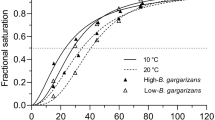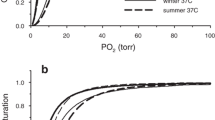Abstract
Red-toothed shrews (subfamily Soricinae) exhibit the highest mass-specific rates of O2 consumption recorded among eutherian mammals, though surprisingly no data appears to be available on the functional characteristics of their hemoglobin (Hb). As a first step in addressing this shortcoming, we investigated the O2 binding characteristics of Taiwanese brown-toothed shrew (Episoriculus fumidus) Hb and its temperature and pH dependence in the absence and presence of anionic red blood cell effectors. Although comparative data regarding the intrinsic O2 affinity of other shrew species are currently unavailable, our data suggest that the sensitivity of this high-elevation endemic species’ Hb to allosteric effector molecules is similar to that of the two lowland species of white-toothed (crocidurine) shrews examined to date. The efficient exploitation of blood O2 reserves by E. fumidus appears to be achieved via synergistic modulation of O2 affinity by Cl− and organic phosphates that moreover dramatically lowers the overall enthalpy of oxygenation of their Hb. Oxygen unloading is presumably further enhanced by a relatively high Bohr effect (ΔLog P 50/ΔpH = −0.69) and marked reduction in the titratable histidine content (predicted low proton buffering value) of the component globin chains relative to human HbA. Notably, however, the limited data available suggest these latter attributes may be widespread among shrews and hence likely are not adaptations to chronic altitudinal hypoxia per se.



Similar content being viewed by others
Abbreviations
- DPG:
-
2,3-Diphosphoglycerate
- Hb:
-
Hemoglobin
- IEF:
-
Isoelectric focusing
- P 50 :
-
O2 tension at 50 % Hb–O2 saturation
- pK a :
-
Logarithmic acid dissociation constant
- n 50 :
-
Hill’s cooperativity coefficient at half saturation
- T b :
-
Body temperature
- pI :
-
Isoelectric point
- PO2 :
-
Partial pressure of oxygen
- ΔH :
-
Enthalpy of oxygenation
References
Atha DH, Ackers GK (1974) Calorimetric determination of the heat of oxygenation of human hemoglobin as a function of pH and the extent of reaction. Biochemistry 13:2376–2382
Bartels H, Bartels R, Baumann R, Fons R, Jürgens KD, Wright P (1979) Blood oxygen transport and organ weights of two shrew species (S. etruscus and C. russula). Am J Physiol 236:R221–R224
Bauer C, Rollema HS, Till HW, Braunitzer G (1980) Phosphate binding by llama and camel hemoglobin. J Comp Physiol B 136:67–70
Berenbrink M (2006) Evolution of vertebrate haemoglobins: histidine side chains, specific buffer value and Bohr effect. Respir Physiol Neurobiol 154:165–184
Campbell KL, Storz JF, Signore AV, Moriyama H, Catania KC, Payson A, Bonaventura J, Stetefeld J, Weber RE (2010a) Molecular basis of a novel adaptation to hypoxic-hypercapnia in a strictly fossorial mole. BMC Evol Biol 10:214
Campbell KL, Roberts JEE, Watson LN, Stetefeld J, Sloan AM, Signore AV, Howatt JW, Tame JRH, Rohland N, Shen T-J, Austin JJ, Hofreiter M, Ho C, Weber RE, Cooper A (2010b) Substitutions in woolly mammoth hemoglobin confer biochemical properties adaptive for cold tolerance. Nat Genet 42:536–540
De Rosa MC, Castagnola M, Bertonati C, Galtier A, Giardina B (2004) From the Arctic to fetal life: physiological importance and structural basis of an ‘additional’ chloride-binding site in haemoglobin. Biochem J 380:889–896
Emmett B, Hochachka PW (1981) Scaling of oxidative and glycolytic enzymes in mammals. Respir Physiol 45:261–272
Foreman CW (1954) A comparative study of the oxygen dissociation of mammalian hemoglobin. J Cell Comp Physiol 44:421–429
Gehr P, Sehovic S, Burri PH, Claassen H, Weibel ER (1980) The lung of shrews: morphometric estimation of diffusion capacity. Respir Physiol 40:33–47
Gusztak RW, MacArthur RA, Campbell KL (2005) Bioenergetics and thermal physiology of the American water shrew (Sorex palustris). J Comp Physiol B 175:87–95
Hofmann O, Carrucan G, Robson N, Brittain T (1995) The chloride effect in the human embryonic haemoglobins. Biochem J 309:959–962
Hutterer R (2005) Order Soricomorpha. In: Wilson DE, Reeder DA (eds) Mammal species of the world: a taxonomical reference, 3rd edn. John Hopkins University Press, Baltimore, pp 220–311
Jameson EW, Jones GS (1977) The Soricidae of Taiwan. Proc Biol Soc Wash 90:459–482
Jelkmann W, Oberthür W, Kleinschmidt T, Braunitzer G (1981) Adaptation of hemoglobin function to subterranean life in the mole, Talpa europaea. Respir Physiol 46:7–16
Jürgens KD, Bartels H, Bartels R (1981) Blood oxygen transport and organ weights of small bats and small non-flying mammals. Respir Physiol 45:243–260
Kramm Ch, Sattrup G, Baumann R, Bartels H (1975) Respiratory function of blood in hibernating and non-hibernating hedgehogs. Respir Physiol 25:311–318
Larimer JL, Schmidt-Nielsen K (1959) A comparison of blood carbonic anhydrase of various mammals. Comp Biochem Physiol 1:19–23
Lindstedt SL (1984) Pulmonary transit time and diffusing capacity in mammals. Am J Physiol 246:R384–R388
Lukin JA, Ho C (2004) The structure–function relationship of hemoglobin in solution at atomic resolution. Chem Rev 104:1219–1230
Maita T, Matsuda G, Takenaka O, Takahashi K (1981) The primary structure of adult hemoglobin of musk shrew (Suncus murinus). Hoppe Seylers Z Physiol Chem 362:1465–1474
McNab BK (1991) The energy expenditure of shrews. In: Findley JS, Yates TL (eds) The biology of the Soricidae. The Museum of Southwestern Biology, University of New Mexico, Albuquerque, pp 35–45
Morrison P, Ryser FA, Dawe AR (1959) Studies on the physiology of the masked shrew Sorex cinereus. Phys Zool 32:256–271
Nowak RM (1999) Walker’s mammals of the world, 6th edn. Johns Hopkins University Press, Baltimore
Opazo JC, Hoffmann FG, Storz JF (2008) Differential loss of embryonic globin genes during the radiation of placental mammals. Proc Natl Acad Sci USA 105:12950–12955
Perutz MF (1983) Species adaptation in a protein molecule. Mol Biol Evol 1:1–28
Perutz MF, Imai K (1980) Regulation of oxygen affinity of mammalian haemoglobins. J Mol Biol 136:183–191
Perutz MF, Kilmartin JV, Nishikura K, Fogg JH, Butler PJG, Rollema HS (1980) Identification of residues contributing to the Bohr effect of human haemoglobin. J Mol Biol 138:649–668
Perutz MF, Fermi G, Poyart C, Pagnier J, Kister J (1993) A novel allosteric mechanism in haemoglobin: structure of bovine deoxyhaemoglobin, absence of specific chloride-binding sites and origin of the chloride-linked Bohr effect in bovine and human haemoglobin. J Mol Biol 233:536–545
Peters T, Kubis HP, Wetzel P, Sender S, Asmussen G, Fons R, Jürgens KD (1999) Contraction parameters, myosin composition and metabolic enzymes of the skeletal muscle of the Etruscan shrew Suncus etruscus and of the common European while-toothed shrew Crocidura russula (Insectivora: Soricidae). J Exp Biol 202:2461–2473
Signore AV, Stetefeld J, Weber RE, Campbell KL (2012) Origin and mechanism of thermal insensitivity in mole hemoglobins: a test of the ‘additional’ chloride binding site hypothesis. J Exp Biol 215:518–525
Stewart JM, Woods AK, Blakely JA (2005) Maximal enzyme activities, and myoglobin and glutathione concentrations in heart, liver and skeletal muscle of the Northern Short-tailed shrew (Blarina brevicauda; Insectivora: Soricidae). Comp Biochem Physiol B Biochem Mol Biol 141:267–273
Storz JF (2007) Hemoglobin function and physiological adaptation to hypoxia in high-altitude mammals. J Mammal 88:24–31
Storz JF, Runck AM, Moriyama H, Weber RE, Fago A (2010) Genetic differences in hemoglobin function between highland and lowland deer mice. J Exp Biol 213:2565–2574
Van Beek GGM, De Bruin SH (1980) Identification of the residues involved in the oxygen-linked chloride-ion binding sites in human deoxyhemoglobin and oxyhemoglobin. Eur J Biochem 105:353–360
Weber RE (1992) Use of ionic and zwitterionic (Tris/BisTris and HEPES) buffers in studies on hemoglobin function. J Appl Physiol 72:1611–1615
Weber RE (2007) High-altitude adaptations in vertebrate hemoglobins. Respir Physiol Neurobiol 158:132–142
Weber RE, Campbell KL (2011) Temperature dependence of haemoglobin–oxygen affinity in heterothermic vertebrates: mechanisms and biological significance. Acta Physiol 202:549–562
Weber RE, Wells RGM (1989) Hemoglobin structure and function. In: Wood C (ed) Comparative pulmonary physiology: current concepts. Marcel Dekker, New York, pp 279–310
Weber RE, Kleinschmidt T, Braunitzer G (1987) Embryonic pig hemoglobins Gower I (ζ2ε2), Gower II (α2ε2), Heide I (ζ2θ2) and Heide II (α2θ2): oxygen-binding functions related to structure and embryonic oxygen supply. Respir Physiol 69:347–357
Yu H-T (1993) Natural history of small mammals of subtropical montane areas in central Taiwan. J Zool (Lond) 231:403–422
Zheng T, Zhu Q, Brittain T (1999) Origin of the suppression of chloride ion sensitivity in human embryonic hemoglobin Gower II. IUBMB Life 48:435–437
Acknowledgments
Funding from the Natural Sciences and Engineering Research Council (NSERC) of Canada (KLC), the Danish Natural Science Research Council (REW) and the Carlsberg Foundation (REW) are gratefully acknowledged. A.V.S. was supported in part by a NSERC Alexander Graham Bell Canada Graduate Scholarship. We also thank M. Berenbrink for helpful discussions regarding the determination and functional consequences of buffering capacity in mammalian hemoglobins.
Author information
Authors and Affiliations
Corresponding author
Additional information
Communicated by I. D. Hume.
Electronic supplementary material
Below is the link to the electronic supplementary material.
Rights and permissions
About this article
Cite this article
Campbell, K.L., Signore, A.V., Harada, M. et al. Molecular and physicochemical characterization of hemoglobin from the high-altitude Taiwanese brown-toothed shrew (Episoriculus fumidus). J Comp Physiol B 182, 821–829 (2012). https://doi.org/10.1007/s00360-012-0659-6
Received:
Revised:
Accepted:
Published:
Issue Date:
DOI: https://doi.org/10.1007/s00360-012-0659-6




